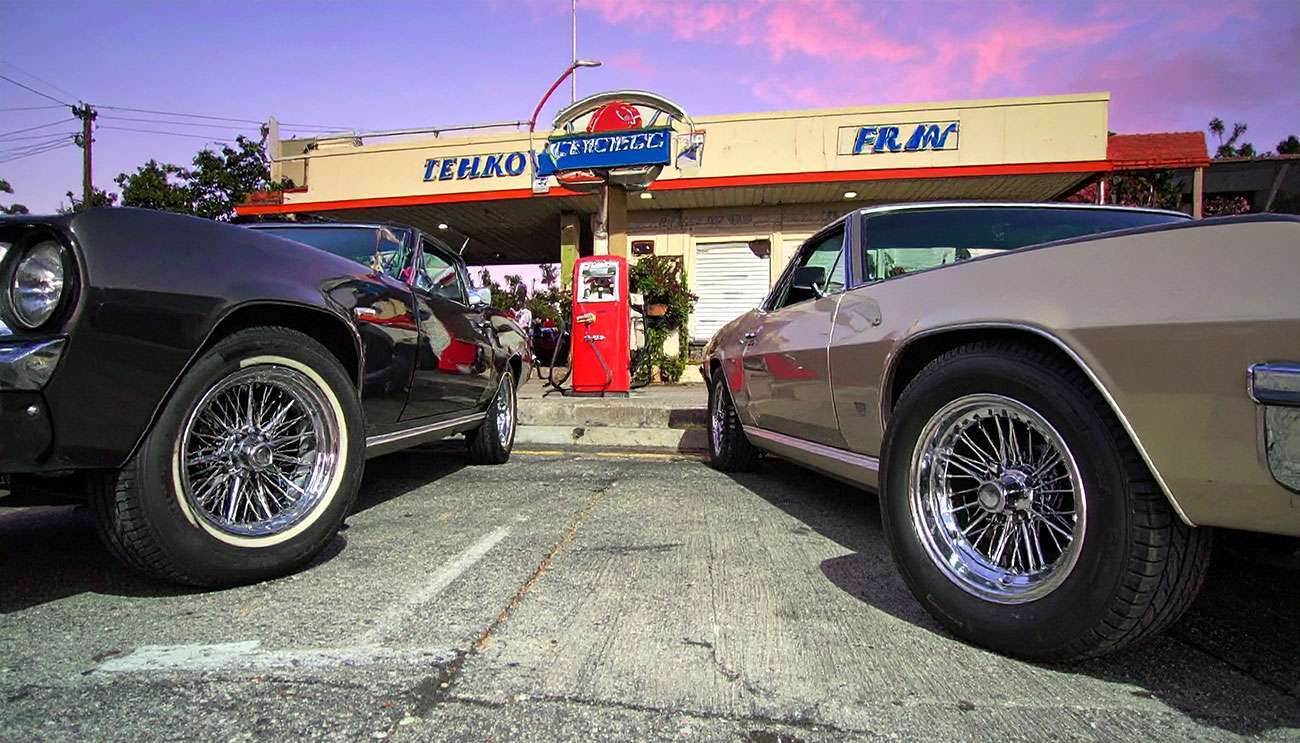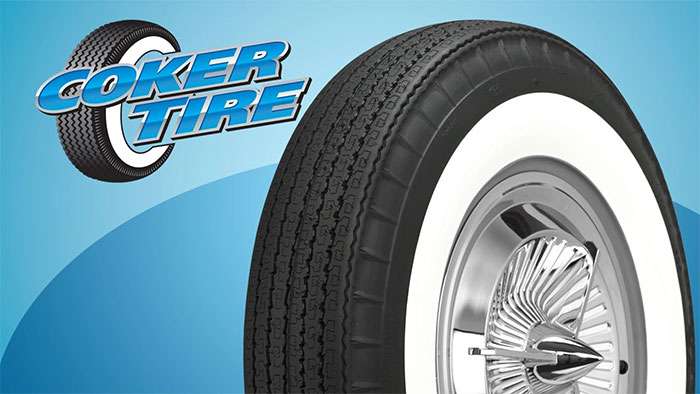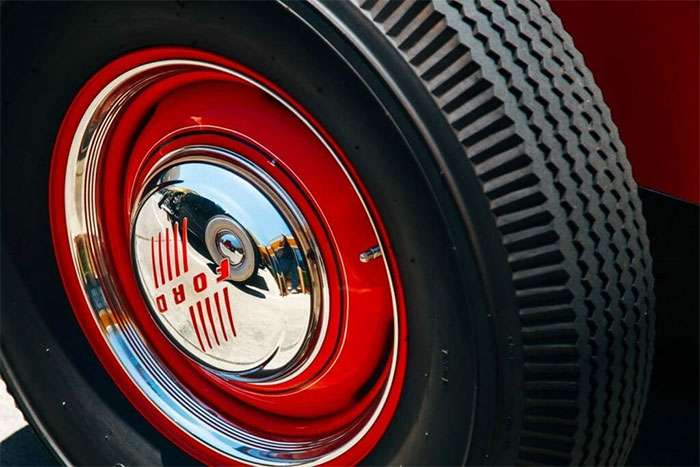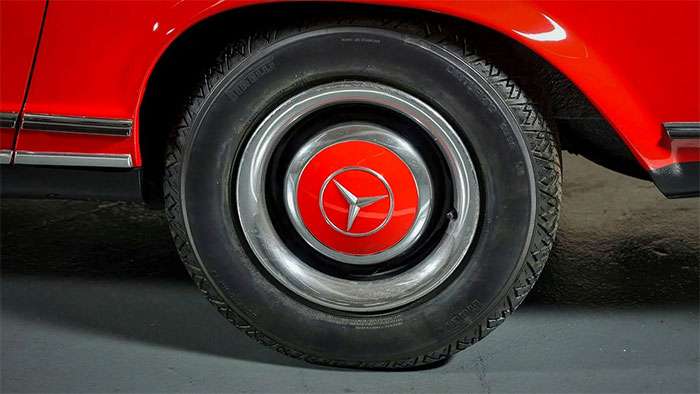
Classic car tires represent the single most critical connection between your vintage vehicle and the road. Modern tire technology delivers substantial safety improvements over original equipment, especially in wet conditions where today's advanced tread patterns evacuate water far more effectively. Recent decades have brought remarkable progress in synthetic polymers, silica compounds, and carbon black formulations that provide superior grip, puncture resistance, and fuel efficiency compared to what your classic originally rolled on.
Selecting the right tires for classic cars demands careful consideration. The wrong choice affects more than just handling and stability - it can diminish your vehicle's appearance and market value. The best classic car tires deliver period-correct appearance while incorporating modern performance capabilities. Coker Tire has dedicated over 65 years to developing specialty products for the classic car market, including their innovative Coker Classic Star Series built from the ground up for vintage applications. Their lineup includes both wide and narrow whitewall options designed specifically for classics spanning the 1940s through 1970s. Quality classic car tires range dramatically in price, from approximately $72 to over $330 per tire depending on brand and specifications.
We've compiled expert recommendations to help you choose the perfect tires for your prized vintage ride. Our guide covers everything from construction differences to brand comparisons, giving you the knowledge to make an informed decision that balances authenticity with modern safety.

Image Source: YouTube
Classic car tires differ significantly from modern options in ways that go far beyond visual appearance. These specialty tires combine period-authentic styling with specific engineering characteristics that directly impact how your vintage vehicle handles and performs.
The construction method creates the primary distinction between vintage and contemporary tires. Classic vehicles originally equipped with bias-ply tires feature cord layers arranged diagonally at 45-degree angles in a distinctive crisscross pattern. This traditional construction method, used since the early 1900s, produces distinctively flatter sidewalls and shoulders that meet the tread at a sharp 90-degree angle. Radial tires became standard between the late 1960s and early 1980s, featuring cords that run at 90-degree angles with steel belt reinforcement under the tread.
Classic car tires feature a uniquely shaped carcass - the industry term for the tire's overall profile. This design results in a smaller contact patch where rubber meets road compared to modern tires. The narrower footprint actually benefits vehicles equipped with manual steering systems, making them considerably easier to turn. The rounded carcass of vintage-style tires rolls differently through aggressive corners, delivering handling characteristics that match what manufacturers originally intended for these vehicles.
Today's tire manufacturers successfully combine authentic vintage appearance with current technology. These specialized tires use premium materials including full-silica tread compounds that deliver heritage styling alongside improved safety performance. Coker Tire pioneered "bias-look radial" construction in 2013, allowing enthusiasts to enjoy authentic bias-ply appearance with modern radial engineering inside. Contemporary rubber compounds provide superior grip, enhanced puncture resistance, and better fuel efficiency than original vintage formulations. These tires also handle temperature variations more effectively while delivering excellent traction across different road surfaces, all while preserving period-correct appearance.

Image Source: Milestar Tires
Choosing between tire types for your classic comes down to how you plan to use your vehicle. Expert mechanics have clear preferences based on decades of experience with different construction styles.
Purists demanding absolute authenticity stick with bias-ply tires for vehicles built before 1975. These tires deliver that unmistakable vintage profile with narrow tread and distinctive bulged sidewalls. They perfectly capture the era-specific appearance that serious restorers require.
The performance trade-offs are significant. Bias-ply tires hunt for ruts and pavement breaks, creating an unsettling wandering sensation. They wear out faster and cost more than modern alternatives. For show cars where historical accuracy matters most, these limitations become acceptable. Daily drivers? That's a different story.
Mechanics who prioritize driving enjoyment recommend radials without hesitation. Manufacturers switched from bias-ply to radial construction between the late 1960s and early 1980s. The radial design flexes better, allowing superior road surface contact.
The advantages are clear: longer tread life, improved handling, better traction, and enhanced stability. Radials excel where bias-ply tires fail completely - wet weather performance. Speeds that would send bias-ply equipped cars "upside-down in the ditch" feel completely secure with radials.
Smart manufacturers solved the classic car owner's dilemma with bias-look radial tires. Companies like Coker Tire engineered these products with modern radial construction hidden inside vintage-style sidewalls. Tire experts call them "simply the best of both worlds".
These tires maintain period-correct appearance with narrow tread patterns and distinctive piecrust shoulders while delivering modern performance. You get the classic look enthusiasts want without the handling quirks that make authentic bias-ply tires challenging to drive. Most weekend cruisers find this the perfect compromise.

Image Source: Hagerty
Professional mechanics rely on proven brands when recommending classic car tires. These manufacturers consistently deliver the quality and performance that vintage vehicle owners demand.
This Dutch-manufactured tire has earned professional respect since its 2001 introduction. Mechanics choose Vredestein for its exceptional balance of period-correct esthetics and modern safety features. The silica-infused compound delivers noticeably better grip and shorter braking distances. Its classic tread design maintains vintage authenticity while the comfortable ride quality often surpasses competitors like the Pirelli CN36.
Michelin's Classic lineup provides era-appropriate styling without performance compromises. The Exalto PE2 targets vehicles from the 1980s through early 2000s with precision. ALM (Adhesion and Longevity Maximized) compound technology creates an asymmetric tread pattern optimized for spirited driving. Four circumferential grooves channel water away from the contact patch, delivering superior wet-weather confidence.
Coker's flagship features genuine whitewalls integrated during the manufacturing process, not painted on afterward. These tires achieve the highest T-speed rating (118 mph) available in any whitewall design. The 480AA UTQG rating ensures excellent treadwear, traction grades, and temperature resistance. Extra Load (XL) rated sidewalls support heavier full-size classics at higher air pressures when required.
Built specifically for muscle cars and street rods, the Radial T/A merges vintage appearance with current manufacturing standards. Customers consistently rate dry traction performance at 9-10 levels. The g-Wedge technology uses high modulus sidewall stabilizers that increase torsional rigidity for enhanced cornering stability. Treadwear scores of 9-10 from users highlight exceptional longevity.
The definitive muscle car tire from 1967-1973, Wide Ovals established the performance look of the era. Current production offers authentic bias ply construction plus modern radial versions with bias-look styling. Made in the USA, the radial version provides authentic looks with modern performance, available with raised white lettering or classic 3/8-inch redlines.
Originally developed in 1968 for the Fiat Dino, the CN36 marked Pirelli's first steel radial tire. This tire powered Pirelli's return to rally competition, collecting numerous victories. Today's CN36 maintains the distinctive tread pattern while incorporating modern materials and construction methods. Popular sizes fit European classics including Porsche 911 and Ferrari models.
Selecting tires for your vintage vehicle means balancing authenticity against practical driving needs. Your choice directly affects both safety and driving enjoyment.
Start by evaluating how you actually use your classic. Show cars displayed primarily at events should stick with period-correct bias-ply tires. Weekend cruisers get the best results from bias-look radials that deliver vintage appearance with modern performance. Classics driven regularly or used for long-distance touring require modern radial tires for their superior durability and wet-weather safety.
Vintage tire sizing presents unique challenges because sizing systems have changed dramatically over the decades. Pre-1960s cars used numeric sizes like "6.70-15," where the first number indicated width in inches. Wrong tire diameter throws off speedometer accuracy—a tire just 3% larger than stock makes your speedometer read 60 mph when you're actually traveling 63.3 mph. Stay within 3% of original diameter specifications to maintain proper calibration.
Sidewall styling makes a dramatic difference in your classic's appearance. Whitewalls appeared in the 1920s and stayed popular through the 1960s. Performance enthusiasts often choose redline tires, which became iconic during the muscle car era. Goldline tires offer something truly distinctive—originally featured on select 1965-66 Corvettes for added luxury and exclusivity.
Wire wheels require inner tubes without exception. Tubeless wheels with tube-type tires need tubes, just like tube-type wheels with tubeless tires. Replace tubes every time you install new tires because rubber tubes deteriorate at the same rate as tires.
Modern tires with wide contact patches can overwork suspension systems designed for narrower footprints. The increased grip stresses components beyond their original design parameters, causing premature wear. Contemporary tires may also deliver a harsher ride that takes away from the authentic vintage driving experience many collectors value.
Choosing the right tires for your classic car comes down to making smart decisions that balance authenticity with performance. Bias-look radials deliver the best solution for most vintage car owners, giving you authentic vintage appearance with modern safety and handling capabilities. This technology lets you maintain your classic's original look while benefiting from decades of tire engineering advances.
Your driving habits determine the best choice for your situation. Show cars that see limited road time can use authentic bias-ply tires for maximum originality. Weekend cruisers and regularly driven classics need modern construction for the safety margins that today's roads demand. Proper sizing remains essential - deviating from original specifications affects handling, speedometer accuracy, and your overall driving experience.
Today's marketplace offers excellent options for classic car owners. Brands like Coker, Vredestein, and Michelin have developed specialized products that address the specific requirements of vintage vehicles. These manufacturers recognize that classic car enthusiasts want both period-correct appearance and reliable performance, creating tires that honor heritage while meeting current safety standards.
Your tires are the only connection between your treasured classic and the road. This investment deserves serious consideration beyond simple price comparisons. The right set of classic car tires enhances your driving enjoyment, preserves your vehicle's value, and keeps you safe during countless miles of memorable drives.
At Performance Plus Tire, we understand the unique requirements of classic car ownership. Our expert team can help you select the perfect tires that match your vehicle's specifications and your driving needs. Whether you're looking for authentic bias-ply construction, modern radials, or bias-look options that offer the best of both worlds, we have the selection and expertise to get you back on the road with confidence.
Expert mechanics recommend specific tire choices that balance vintage esthetics with modern safety and performance for classic car enthusiasts.
• Bias-look radial tires offer the best compromise - combining authentic vintage appearance with modern radial construction for superior handling and safety
• Match tire choice to your driving style - show cars can use authentic bias-ply, while regularly driven classics need modern radials for safety
• Trusted brands include Vredestein Sprint Classic, Coker Classic Star Series, and Michelin XAS - these manufacturers specialize in classic car applications
• Stay within 3% of original tire diameter - larger deviations affect speedometer accuracy and handling characteristics of vintage suspension systems
• Wire wheels always require inner tubes - and tubes should be replaced whenever installing new tires due to rubber deterioration
The key is finding tires that respect your classic's heritage while providing the safety margins that modern driving conditions demand. Quality classic car tires are an investment in both performance and preservation of your vintage vehicle's value.
Yes, you can put modern tires on many classic cars, especially those built after the mid-1950s. However, it's important to choose tires that match the original specifications and don't negatively impact the car's handling or esthetics. Bias-look radial tires often offer the best compromise between vintage appearance and modern performance.
Bias-look radial tires combine modern radial construction with the appearance of traditional bias-ply tires. They offer improved performance, safety, and longevity while maintaining a period-correct esthetic for classic cars. These tires are often recommended by experts as they provide the best of both worlds for vintage vehicle owners.
When selecting tires for a classic car, it's crucial to stay within 3% of the original tire diameter. This ensures proper speedometer accuracy and maintains the vehicle's intended handling characteristics. Consult your car's manual or a classic car tire specialist to determine the correct size and specifications for your specific model.
Yes, whitewall tires are still available for classic cars. Many manufacturers, such as Coker Tire, produce whitewall tires specifically designed for vintage vehicles. These tires come in various styles, including narrow and wide whitewalls, to complement classics from different eras.
Even if your classic car's tires look good and have low mileage, it's recommended to replace them every 7-10 years due to rubber degradation. Factors like storage conditions and frequency of use can affect tire lifespan. Always inspect your tires regularly for signs of wear, cracking, or dry rot, and replace them if you notice any issues.